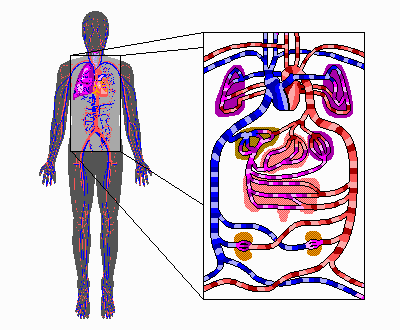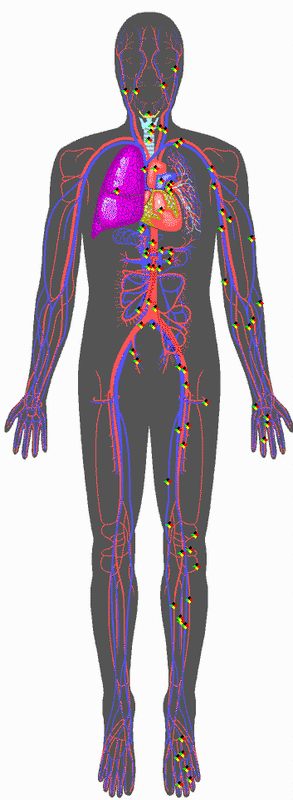Cardiovascular System (Simplified)
The cardiovascular system includes the heart and the blood vessels. The heart pumps blood, and the blood vessels channel and deliver it throughout the body. Arteries carry blood filled with nutrients away from the heart to all parts of the body. The blood is sometimes compared to a river, but the arteries are more like a river in reverse. Arteries are thick-walled tubes with a circular covering of yellow, elastic fibers, which contain a filling of muscle that absorbs the tremendous pressure wave of a heartbeat and slows the blood down. This pressure can be felt in the arm and wrist - it is the pulse. Eventually arteries divide into smaller arterioles and then into even smaller capillaries, the smallest of all blood vessels. One arteriole can serve a hundred capillaries. Here, in every tissue of every organ, blood's work is done when it gives up what the cells need and takes away the waste products that they don't need. Now the river comparison really does apply. Capillaries join together to form small veins, which flow into larger main veins, and these deliver deoxygenated blood back to the heart. Veins, unlike arteries, have thin, slack walls, because the blood has lost the pressure which forced it out of the heart, so the dark, reddish-blue blood which flows through the veins on its way to the lungs oozes along very slowly on its way to be reoxygenated. Back at the heart, the veins enter a special vessel, called the pulmonary arteries, into the wall at right side of the heart. It flows along the pulmonary arteries to the lungs to collect oxygen, then back to the heart's left side to begin its journey around the body again.
The cardiovascular system includes the heart and the blood vessels. The heart pumps blood, and the blood vessels channel and deliver it throughout the body. Arteries carry blood filled with nutrients away from the heart to all parts of the body. The blood is sometimes compared to a river, but the arteries are more like a river in reverse. Arteries are thick-walled tubes with a circular covering of yellow, elastic fibers, which contain a filling of muscle that absorbs the tremendous pressure wave of a heartbeat and slows the blood down. This pressure can be felt in the arm and wrist - it is the pulse. Eventually arteries divide into smaller arterioles and then into even smaller capillaries, the smallest of all blood vessels. One arteriole can serve a hundred capillaries. Here, in every tissue of every organ, blood's work is done when it gives up what the cells need and takes away the waste products that they don't need. Now the river comparison really does apply. Capillaries join together to form small veins, which flow into larger main veins, and these deliver deoxygenated blood back to the heart. Veins, unlike arteries, have thin, slack walls, because the blood has lost the pressure which forced it out of the heart, so the dark, reddish-blue blood which flows through the veins on its way to the lungs oozes along very slowly on its way to be reoxygenated. Back at the heart, the veins enter a special vessel, called the pulmonary arteries, into the wall at right side of the heart. It flows along the pulmonary arteries to the lungs to collect oxygen, then back to the heart's left side to begin its journey around the body again.


